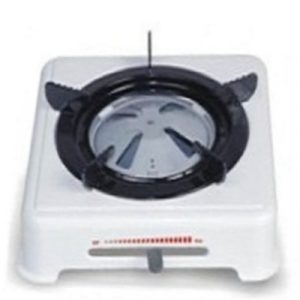
Agriculture
February 3, 2024
KIKE Green Cook KD1
Read SolutionImplemented by
GEBiofuels
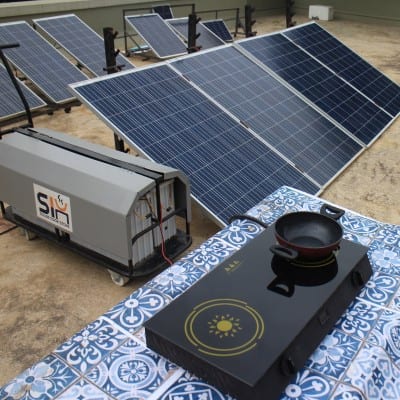
Updated on February 3, 2024
·Created on October 2, 2020
The Solar PV Cook-stove cooks food day and night using induction heating powered by electricity from solar PV panels that is stored in batteries.
The Solar PV Cook-stove is designed to use sunlight to cook all types of food typically eaten in India, at any time of day or night. It uses induction rings to heat the pan/pot meaning it can be used to cook indoors and can achieve temperatures over 160°C making it capable of being used for cooking all types of typical Indian cuisine.
The system is capable of supplying 3 kWh of energy sufficient to cook 3 meals per day for a 5 person family. It is powered by 4 solar PV panels providing 1 kW of power, with 4 Lead Acid batteries (total storage 7 kWh) to enable cooking at night and provide a day of back up for rainy or overcast conditions.
The Solar PV Cook-stove was designed and developed by Solar Urja through Localization for Sustainability (SoULS) initiative of the Indian Institute of Technology (IIT) Bombay. It is currently being piloted in Bancha village of Betul district, Madhya Pradesh, India.
Target SDGs
SDG 7: Affordable and Clean Energy
SDG 13: Climate Action
Market Suggested Retail Price
$925.00
Target Users (Target Impact Group)
Household
Distributors / Implementing Organizations
The Energy Swaraj Foundation which manufactures the solar PV cook-stoves currently takes orders online and distributes the cook-stoves themselves, however they are looking for distributors to work with them retailing the cook-stove worldwide.Interview with representative in 2020 The pilot is being implemented through a collaboration between IIT-Bombay, an NGO in Betul district, Madhya Pradesh called Bharat Bharti Shiksha Samiti and the Oil and Natural Gas Corporation (ONGC).
Competitive Landscape
Direct competitors include Sunspot Electric Stove.
Regions
Worldwide
Manufacturing/Building Method
The Solar PV Cook-stove is being manufactured by the Energy Swaraj Foundation in Mumbai. Interview with representative in 2020 in 2020
Intellectural Property Type
Select Type
User Provision Model
The Solar PV Cook-stove is currently available to purchase commercially from the Energy Swaraj Foundation, but the PCB designs are open for all to use.Interview with representativ in 2020
Those who live in Bancha Village, Betul District, Madhya Pradesh, obtained the stove through IIT-Bombay's collaboration with Bharat Bharti Shiksha Samiti.
Distributions to Date Status
Up to January 2020 when commercial sales started, 86 solar PV cook-stoves had been distributed with funding from ONGC, including covering all the families in Bancha village under the pilot program. From commencement of commercial sales in January 2020 to March 2020, 5 complete solar PV cook-stove systems were sold. Interview with representative in 2020
Forced or passive
N/A
Power output in full sunlight (W)
1000 W
Max temperature (°C)
288 °C
Pot capacity (L)
5 L
Oven volume (L)
N/A
Pot type
Flat bottom
Time to boil (min/L)
20 min/L
Design Specifications
The Solar PV Cook-stove is designed to use sunlight to cook all types of food typically eaten in India, at any time of day or night.
The design includes one or two 1 kW induction rings depending on the model and an optional 500 W resistive cooker to heat the pots and pans. The induction rings are capable of producing cooking temperatures over 160 °C making it capable of being used for cooking all types of typical Indian cuisine. The developers specify that "It can be used for all cooking processes like boiling, steaming, frying, griddling, etc."
The largest version of the system is capable of supplying 3 kWh of energy sufficient to cook 3 meals per day for a 5 person family. It operates on 48 V DC electricity produced by 4 solar PV panels providing a total of 1 kW of power. 4 Lead Acid batteries (total storage 7 kWh) enable cooking at night and provide a day of back up for rainy or overcast conditions.
The induction rings are housed in a plastic casing designed to increase durability and ease of use of the cookstove and safety for the user. The casing has a battery power meter to indicate it's state of charge and usage and ventilation gaps in the sides. For the larger model, the rings power levels are adjusted using rotatable knobs similar to those found on typical electric hobs for usability, while on the smaller model three switches control the degree of heat.
The commercially available smaller model of the cookstove (single ring) weighs approximately 1 kg (excluding panels and batteries) and has the following specifications:
| Component | Specifications |
|---|---|
| Heating Coil | 100% Pure Copper litz wire Coil |
| Maximum Power Output | A-Grade High Strength German Crystal Top Plate |
| Top Plate Material | 100% Pure Copper litz wire Coil |
| Input Voltage | 40 V to 60 V DC |
| Battery level Display | Yes (LED’s with ) |
| Power Adjustments (W) | 3 levels ( 700-1000 W) |
| Auto Pan detection, Switch off | Yes, Automatically switch off when no pan on the induction cooker |
| Utensil to be Used | Use Flat-Bottom Normal Stainless Steel Utensils only |
| Internal Cooling Fan Type | DC Fan 18V |
| PCB Quality | A-Grade Quality |
| Body Material | ABS Mixed PP Plastic For High Strength |
| Warranty | 1 Year Manufacturer Warranty |
| Compliance | Compliance with ISO 9001-2008 Certified |
Technical Support
For those using the product in Bancha village under the pilot, two villagers have been trained to maintain the stoves, and IIT-Bombay are still monitoring the pilot so can provide additional technical support as needed.
Replacement Components
Replaceable components include the batteries and solar panels.
Lifecycle
Dr. Solanki, a professor at IIT-Bombay who supervised the team that designed the Solar PV Cook-stove, estimates the lifetime for similar products at 20 years and 5 years for batteries. A 1 year manufacturer's warranty is provided with the cookstove.
Manufacturer Specified Performance Parameters
The product was designed to achieve a high score in all of the 5C's (Convenience, Control, Cost-effectiveness, clean and compactness) which are criteria for comparing modern cooking solutions.
It was intended to not produce any air pollution to address the indoor air pollution problem with existing stoves that have caused negative health outcomes.
It can fulfill the energy demand to cook 3 meals a day for a family of 5 people and can be operated at night in contrast to other solar cookstoves.
Vetted Performance Status
Testing performed by the manufacturer determined the cookstove offers 3-4 hour cooking time per day on a full charge and is both suitable for all types of domestic cooking processes and sufficient for a family of 5 members. Manufacturer testing results are in the below table. No third-party testing has been completed. Interview with representative in 2020
Safety
The product uses a 48 V DC power supply from it's solar panels and batteries to improve electrical safety, however users should take appropriate precautions when using electrical devices and be cautious that the stove-top may remain hot for some time after cooking.
Complementary Technical Systems
Use of insulated vessels capable of induction cooking can reduce the energy requirement for the cookstove by 10%.
It would be possible to power other electrical appliances using the electricity stored in the lead-acid batteries.
IIT Bombay has also developed a solar PV rice cooker and a solar tea cart.
Academic Research and References
Sasihithlu, K., Telagamsetti, S., Kulkarni, P., 2018, Design, development of the Solar PV based rice cooker for indoor applications. Tata Centre for Technology and Design.
Solanki, C.S., 2018, Dawn of Solar PV Cooking. Akshay Urja, 6.
Further research regarding solar electric cooking:
Watkins, T., Arroyo, P., Perry, R., Wang, R., Arriaga, O., Fleming, M., O’Day, C., Stone, I., Sekerak, J., Mast, D., Hayes, N., Keller, P., Schwartz, P., 2017, Insulated Solar Electric Cooking – Tomorrow’s healthy affordable stoves? Development Engineering, 2, pp. 47-52.
Batchelor, S., Talukder, M.A.R., Uddin, M.R., Mondal, S.K., Islam, S., Redoy, R.K., Hanlin, R., Khan, M.R., 2018, Solar e-Cooking: A Proposition for Solar Home System Integrated Clean Cooking. Energies, 11(11), 2933.
Batchelor, S., 2015, Solar Electric Cooking in Africa in 2020: A synthesis of the possibilities. Department for International Development Report.
Natural Energy Solutions, 2018, Solar PV Cook stoves for clean energy cooking, Natural Energy Solutions
Solanki, C. S., 2018, Dawn of Solar PV Cooking, Linkedin
Energy World, 2019, Electric cooking starts to simmer in rural India, Energy World
Karelia, G., 2019, Thanks to IIT-B’s Invention, MP Gets India’s First Village With All-Solar Kitchens, The better India
Compliance with regulations
The solar PV cookstove is ISO 9001-2008 certified.
Evaluation methods
The cook-stove is designed for DC source applications like solar panels, battery etc. The PCB is designed for input voltage of 42-60V operation. Evaluation methods include:Interview with representative in 2020
a) Time to cook different food items
b) Stove performance for varied users and dishes
c) Energy required for various food items
Other Information
In September 2018, a Know-how and licensing transfer event was held to share knowledge and licensing rights relating to the product with other parties.
A video of Prof Solanki presenting his research on the Dawn of Solar PV Cooking (linked in academic research above) can be found here.
Two videos demonstrating the Solar PV Cook-stove can be found here and here.
The Solar PV Cook-stove is currently being piloted in 74 homes in Bancha village of Betul district, Madhya Pradesh, India. India Today produced a video showing the impact of the solar PV cook-stove on Bacha village in Betul district, Madhya Pradesh.
There are plans to expand the pilot to a village in Hoshangabad district, Madhya Pradesh.
This product won the Oil and Natural Gas Corporation's Solar Chulha Challenge which was intended to encourage development of an alternative to the biomass-fueled chulhas used by 700 million Indians.
Here are several photos showing internal components of the stove:

Agriculture
February 3, 2024
Implemented by
GEBiofuels
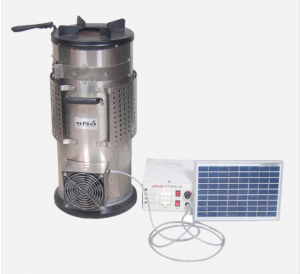
Agriculture
November 30, 2024
Implemented by
NDMI Renewable Energy Private Limited
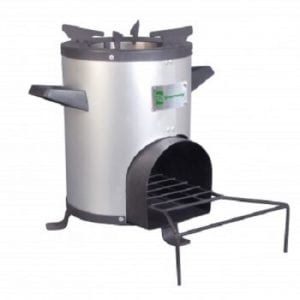
Agriculture
December 3, 2024
Implemented by
Greenway
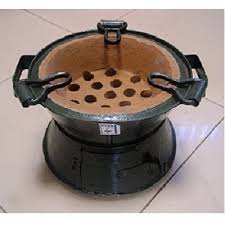
Agriculture
February 1, 2024
Implemented by
Kenya Energy and Environment Organisations (KENGO)
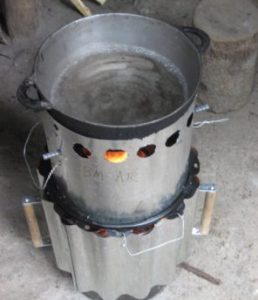
Agriculture
December 29, 2023
Implemented by
SeaChar
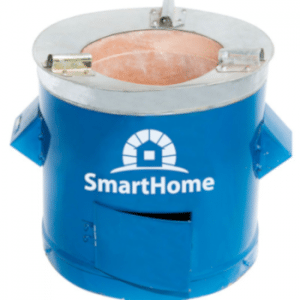
Agriculture
December 27, 2023
Implemented by
Green Bio Energy
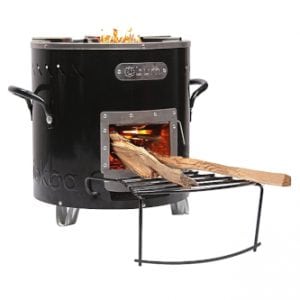
Agriculture
January 10, 2024
Implemented by
BURN Design Lab
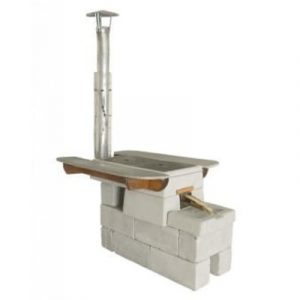
Agriculture
December 27, 2023
Implemented by
Helps International
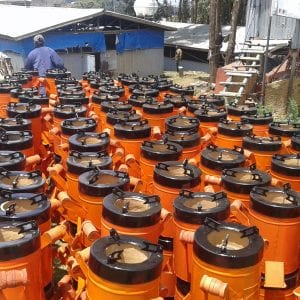
Agriculture
December 3, 2024
Implemented by
Gogle
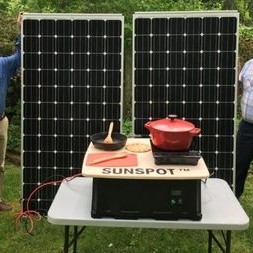
Agriculture
January 27, 2024
Implemented by
Sunspot PV LLC
Have thoughts on how we can improve?
Give Us Feedback